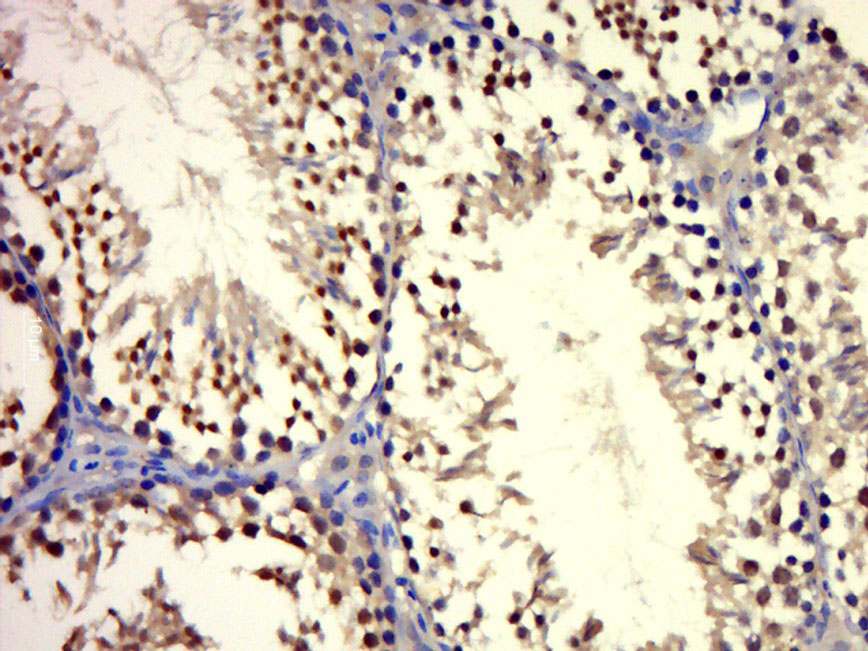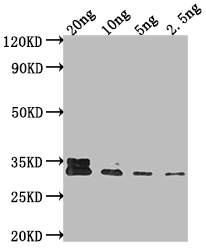![Androgen Receptor antibody [HL1049] detects Androgen Receptor protein by immunohistochemical analysis. Sample: Paraffin-embedded rat tissues. Androgen Receptor stained by Androgen Receptor antibody [HL1049] (GTX636021) diluted at 1:100. Antigen Retrieval: Citrate buffer, pH 6.0, 15 min Androgen Receptor antibody [HL1049] detects Androgen Receptor protein by immunohistochemical analysis. Sample: Paraffin-embedded rat tissues. Androgen Receptor stained by Androgen Receptor antibody [HL1049] (GTX636021) diluted at 1:100. Antigen Retrieval: Citrate buffer, pH 6.0, 15 min](https://www.genetex.com/upload/website/prouct_img/normal/GTX636021/GTX636021_44277_20221223_IHC-P_multiple_R_22122821_517.webp)
Androgen Receptor antibody [HL1049] detects Androgen Receptor protein by immunohistochemical analysis. Sample: Paraffin-embedded rat tissues. Androgen Receptor stained by Androgen Receptor antibody [HL1049] (GTX636021) diluted at 1:100. Antigen Retrieval: Citrate buffer, pH 6.0, 15 min
Androgen Receptor antibody [HL1049]
GTX636021
ApplicationsImmunoFluorescence, Western Blot, ImmunoCytoChemistry, ImmunoHistoChemistry, ImmunoHistoChemistry Paraffin
Product group Antibodies
ReactivityHuman, Rat
TargetAR
Overview
- SupplierGeneTex
- Product NameAndrogen Receptor antibody [HL1049]
- Delivery Days Customer9
- Application Supplier NoteWB: 1:500-1:3000. *Optimal dilutions/concentrations should be determined by the researcher.Not tested in other applications.
- ApplicationsImmunoFluorescence, Western Blot, ImmunoCytoChemistry, ImmunoHistoChemistry, ImmunoHistoChemistry Paraffin
- CertificationResearch Use Only
- ClonalityMonoclonal
- Clone IDHL1049
- Concentration1 mg/ml
- ConjugateUnconjugated
- Gene ID367
- Target nameAR
- Target descriptionandrogen receptor
- Target synonymsAIS, AR8, DHTR, HUMARA, HYSP1, KD, NR3C4, SBMA, SMAX1, TFM, androgen receptor, dihydrotestosterone receptor, nuclear receptor subfamily 3 group C member 4
- HostRabbit
- IsotypeIgG
- Protein IDP10275
- Protein NameAndrogen receptor
- Scientific DescriptionThe androgen receptor gene is more than 90 kb long and codes for a protein that has 3 major functional domains: the N-terminal domain, DNA-binding domain, and androgen-binding domain. The protein functions as a steroid-hormone activated transcription factor. Upon binding the hormone ligand, the receptor dissociates from accessory proteins, translocates into the nucleus, dimerizes, and then stimulates transcription of androgen responsive genes. This gene contains 2 polymorphic trinucleotide repeat segments that encode polyglutamine and polyglycine tracts in the N-terminal transactivation domain of its protein. Expansion of the polyglutamine tract from the normal 9-34 repeats to the pathogenic 38-62 repeats causes spinal bulbar muscular atrophy (SBMA, also known as Kennedys disease). Mutations in this gene are also associated with complete androgen insensitivity (CAIS). Alternative splicing results in multiple transcript variants encoding different isoforms. [provided by RefSeq, Jan 2017]
- ReactivityHuman, Rat
- Storage Instruction-20°C or -80°C,2°C to 8°C
- UNSPSC12352203

![Various whole cell extracts (30 μg) were separated by 5% SDS-PAGE, and the membrane was blotted with Androgen Receptor antibody [HL1049] (GTX636021) diluted at 1:5000. The HRP-conjugated anti-rabbit IgG antibody (GTX213110-01) was used to detect the primary antibody. Various whole cell extracts (30 μg) were separated by 5% SDS-PAGE, and the membrane was blotted with Androgen Receptor antibody [HL1049] (GTX636021) diluted at 1:5000. The HRP-conjugated anti-rabbit IgG antibody (GTX213110-01) was used to detect the primary antibody.](https://www.genetex.com/upload/website/prouct_img/normal/GTX636021/GTX636021_44277_20220408_WB_w_23061202_386.webp)
![Androgen Receptor antibody [HL1049] detects Androgen Receptor protein at nucleus by immunohistochemical analysis. Sample: Paraffin-embedded human prostate cancer. Androgen Receptor stained by Androgen Receptor antibody [HL1049] (GTX636021) diluted at 1:500. Antigen Retrieval: Citrate buffer, pH 6.0, 15 min Androgen Receptor antibody [HL1049] detects Androgen Receptor protein at nucleus by immunohistochemical analysis. Sample: Paraffin-embedded human prostate cancer. Androgen Receptor stained by Androgen Receptor antibody [HL1049] (GTX636021) diluted at 1:500. Antigen Retrieval: Citrate buffer, pH 6.0, 15 min](https://www.genetex.com/upload/website/prouct_img/normal/GTX636021/GTX636021_44277_20220318_IHC-P_1_w_23061202_296.webp)
![Various whole cell extracts (30 μg) were separated by 5% SDS-PAGE, and the membrane was blotted with Androgen Receptor antibody [HL1049] (GTX636021) diluted at 1:1000. The HRP-conjugated anti-rabbit IgG antibody (GTX213110-01) was used to detect the primary antibody. Various whole cell extracts (30 μg) were separated by 5% SDS-PAGE, and the membrane was blotted with Androgen Receptor antibody [HL1049] (GTX636021) diluted at 1:1000. The HRP-conjugated anti-rabbit IgG antibody (GTX213110-01) was used to detect the primary antibody.](https://www.genetex.com/upload/website/prouct_img/normal/GTX636021/GTX636021_44277_20210409_WB_w_23061202_660.webp)
![Androgen Receptor antibody [HL1049] detects Androgen Receptor protein at nucleus by immunohistochemical analysis. Sample: Paraffin-embedded human prostate cancer. Androgen Receptor stained by Androgen Receptor antibody [HL1049] (GTX636021) diluted at 1:500. Antigen Retrieval: Citrate buffer, pH 6.0, 15 min Androgen Receptor antibody [HL1049] detects Androgen Receptor protein at nucleus by immunohistochemical analysis. Sample: Paraffin-embedded human prostate cancer. Androgen Receptor stained by Androgen Receptor antibody [HL1049] (GTX636021) diluted at 1:500. Antigen Retrieval: Citrate buffer, pH 6.0, 15 min](https://www.genetex.com/upload/website/prouct_img/normal/GTX636021/GTX636021_44277_20220318_IHC-P_w_23061202_877.webp)
![Androgen Receptor antibody [HL1049] detects Androgen Receptor protein at nucleus by immunofluorescent analysis. Sample: 22RV1 cells were fixed in 4% paraformaldehyde at RT for 15 min. Green: Androgen Receptor stained by Androgen Receptor antibody [HL1049] (GTX636021) diluted at 1:500. Red: alpha Tubulin, a cytoskeleton marker, stained by alpha Tubulin antibody [GT114] (GTX628802) diluted at 1:1000. Androgen Receptor antibody [HL1049] detects Androgen Receptor protein at nucleus by immunofluorescent analysis. Sample: 22RV1 cells were fixed in 4% paraformaldehyde at RT for 15 min. Green: Androgen Receptor stained by Androgen Receptor antibody [HL1049] (GTX636021) diluted at 1:500. Red: alpha Tubulin, a cytoskeleton marker, stained by alpha Tubulin antibody [GT114] (GTX628802) diluted at 1:1000.](https://www.genetex.com/upload/website/prouct_img/normal/GTX636021/GTX636021_T-44228_20210416_ICC_IF_w_23061202_549.webp)






